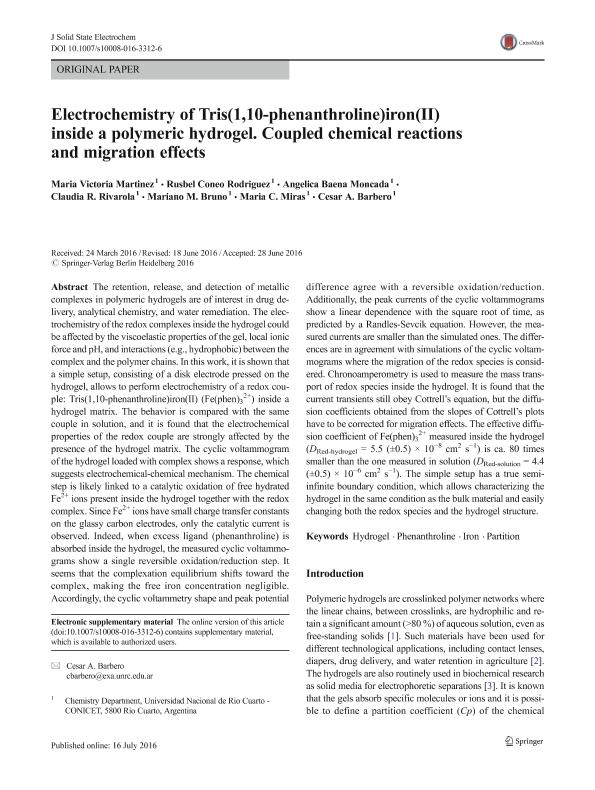Mostrar el registro sencillo del ítem
dc.contributor.author
Martinez, María Victoria

dc.contributor.author
Coneo Rodriguez, Rusbel

dc.contributor.author
Baena Moncada, Angelica Maria

dc.contributor.author
Rivarola, Claudia Rosana

dc.contributor.author
Bruno, Mariano Martín

dc.contributor.author
Miras, Maria Cristina

dc.contributor.author
Barbero, César Alfredo

dc.date.available
2020-09-18T12:27:27Z
dc.date.issued
2016-07
dc.identifier.citation
Martinez, María Victoria; Coneo Rodriguez, Rusbel; Baena Moncada, Angelica Maria; Rivarola, Claudia Rosana; Bruno, Mariano Martín; et al.; Electrochemistry of Tris(1,10-phenanthroline)iron(II) inside a polymeric hydrogel. Coupled chemical reactions and migration effects; Springer; Journal of Solid State Electrochemistry (print); 20; 7-2016; 2951-2960
dc.identifier.issn
1432-8488
dc.identifier.uri
http://hdl.handle.net/11336/114275
dc.description.abstract
The retention, release, and detection of metallic complexes in polymeric hydrogels are of interest in drug delivery, analytical chemistry, and water remediation. The electrochemistry of the redox complexes inside the hydrogel could be affected by the viscoelastic properties of the gel, local ionic force and pH, and interactions (e.g., hydrophobic) between the complex and the polymer chains. In this work, it is shown that a simple setup, consisting of a disk electrode pressed on the hydrogel, allows to perform electrochemistry of a redox couple: Tris(1,10-phenanthroline)iron(II) (Fe(phen)3 2+) inside a hydrogel matrix. The behavior is compared with the same couple in solution, and it is found that the electrochemical properties of the redox couple are strongly affected by the presence of the hydrogel matrix. The cyclic voltammogram of the hydrogel loaded with complex shows a response, which suggests electrochemical-chemical mechanism. The chemical step is likely linked to a catalytic oxidation of free hydrated Fe2+ ions present inside the hydrogel together with the redox complex. Since Fe2+ ions have small charge transfer constants on the glassy carbon electrodes, only the catalytic current is observed. Indeed, when excess ligand (phenanthroline) is absorbed inside the hydrogel, the measured cyclic voltammograms show a single reversible oxidation/reduction step. It seems that the complexation equilibrium shifts toward the complex, making the free iron concentration negligible. Accordingly, the cyclic voltammetry shape and peak potential difference agree with a reversible oxidation/reduction. Additionally, the peak currents of the cyclic voltammograms show a linear dependence with the square root of time, as predicted by a Randles-Sevcik equation. However, the measured currents are smaller than the simulated ones. The differences are in agreement with simulations of the cyclic voltammograms where the migration of the redox species is considered. Chronoamperometry is used to measure the mass transport of redox species inside the hydrogel. It is found that the current transients still obey Cottrell?s equation, but the diffusion coefficients obtained from the slopes of Cottrell?s plots have to be corrected for migration effects. The effective diffusion coefficient of Fe(phen)3 2+ measured inside the hydrogel (DRed-hydrogel = 5.5 (±0.5) × 10−8 cm2 s−1) is ca. 80 times smaller than the one measured in solution (DRed-solution = 4.4 (±0.5) × 10−6 cm2 s−1). The simple setup has a true semi-infinite boundary condition, which allows characterizing the hydrogel in the same condition as the bulk material and easily changing both the redox species and the hydrogel structure.
dc.format
application/pdf
dc.language.iso
eng
dc.publisher
Springer

dc.rights
info:eu-repo/semantics/openAccess
dc.rights.uri
https://creativecommons.org/licenses/by-nc-sa/2.5/ar/
dc.subject
HYDROGEL
dc.subject
IRON
dc.subject
PARTITION
dc.subject
PHENANTHROLINE
dc.subject.classification
Físico-Química, Ciencia de los Polímeros, Electroquímica

dc.subject.classification
Ciencias Químicas

dc.subject.classification
CIENCIAS NATURALES Y EXACTAS

dc.title
Electrochemistry of Tris(1,10-phenanthroline)iron(II) inside a polymeric hydrogel. Coupled chemical reactions and migration effects
dc.type
info:eu-repo/semantics/article
dc.type
info:ar-repo/semantics/artículo
dc.type
info:eu-repo/semantics/publishedVersion
dc.date.updated
2020-09-17T14:40:59Z
dc.journal.volume
20
dc.journal.pagination
2951-2960
dc.journal.pais
Alemania

dc.journal.ciudad
Berlin
dc.description.fil
Fil: Martinez, María Victoria. Universidad Nacional de Río Cuarto. Facultad de Ciencias Exactas Fisicoquímicas y Naturales. Departamento de Química; Argentina. Consejo Nacional de Investigaciones Científicas y Técnicas; Argentina
dc.description.fil
Fil: Coneo Rodriguez, Rusbel. Universidad Nacional de Río Cuarto. Facultad de Ciencias Exactas Fisicoquímicas y Naturales. Departamento de Química; Argentina. Consejo Nacional de Investigaciones Científicas y Técnicas; Argentina
dc.description.fil
Fil: Baena Moncada, Angelica Maria. Universidad Nacional de Río Cuarto. Facultad de Ciencias Exactas Fisicoquímicas y Naturales. Departamento de Química; Argentina. Consejo Nacional de Investigaciones Científicas y Técnicas; Argentina
dc.description.fil
Fil: Rivarola, Claudia Rosana. Universidad Nacional de Río Cuarto. Facultad de Ciencias Exactas Fisicoquímicas y Naturales. Departamento de Química; Argentina. Consejo Nacional de Investigaciones Científicas y Técnicas; Argentina
dc.description.fil
Fil: Bruno, Mariano Martín. Universidad Nacional de Río Cuarto. Facultad de Ciencias Exactas Fisicoquímicas y Naturales. Departamento de Química; Argentina. Consejo Nacional de Investigaciones Científicas y Técnicas; Argentina
dc.description.fil
Fil: Miras, Maria Cristina. Universidad Nacional de Río Cuarto. Facultad de Ciencias Exactas Fisicoquímicas y Naturales. Departamento de Química; Argentina
dc.description.fil
Fil: Barbero, César Alfredo. Consejo Nacional de Investigaciones Científicas y Técnicas; Argentina. Universidad Nacional de Río Cuarto. Facultad de Ciencias Exactas Fisicoquímicas y Naturales. Departamento de Química; Argentina
dc.journal.title
Journal of Solid State Electrochemistry (print)

dc.relation.alternativeid
info:eu-repo/semantics/altIdentifier/doi/http://dx.doi.org/ 10.1007/s10008-016-3312-6
dc.relation.alternativeid
info:eu-repo/semantics/altIdentifier/url/https://link.springer.com/article/10.1007%2Fs10008-016-3312-6
Archivos asociados
